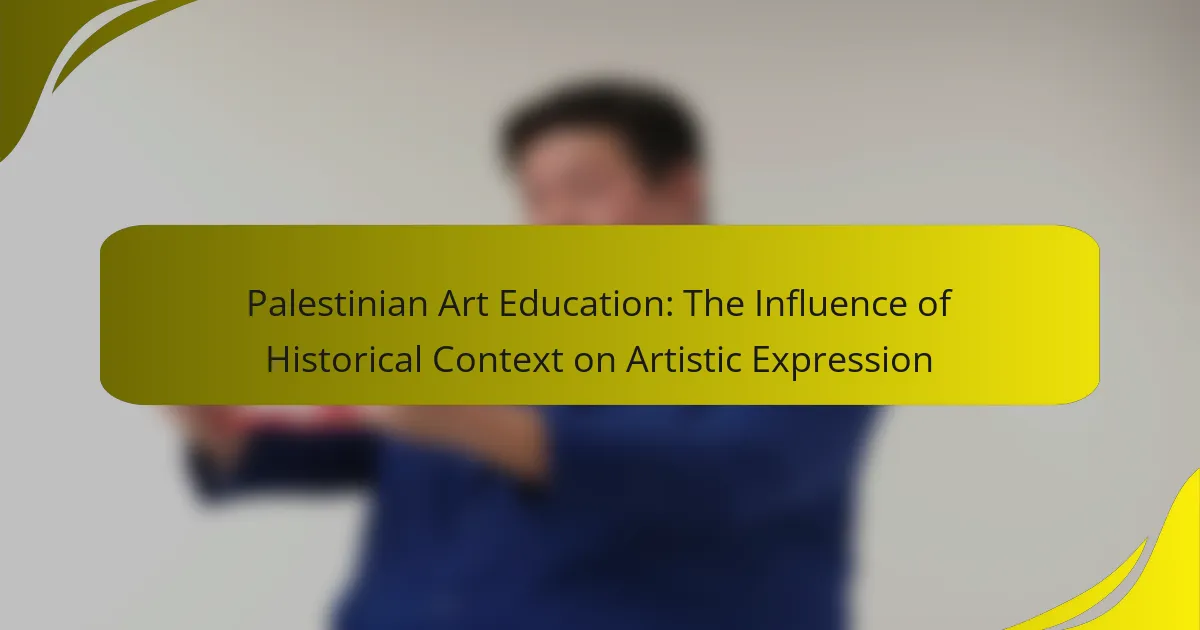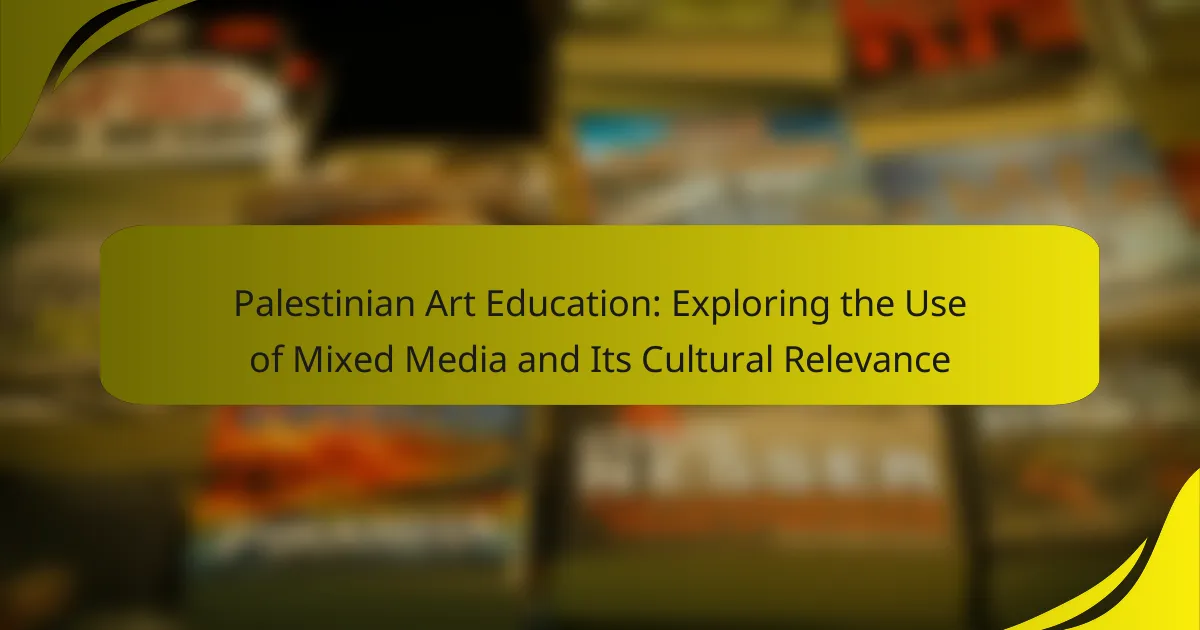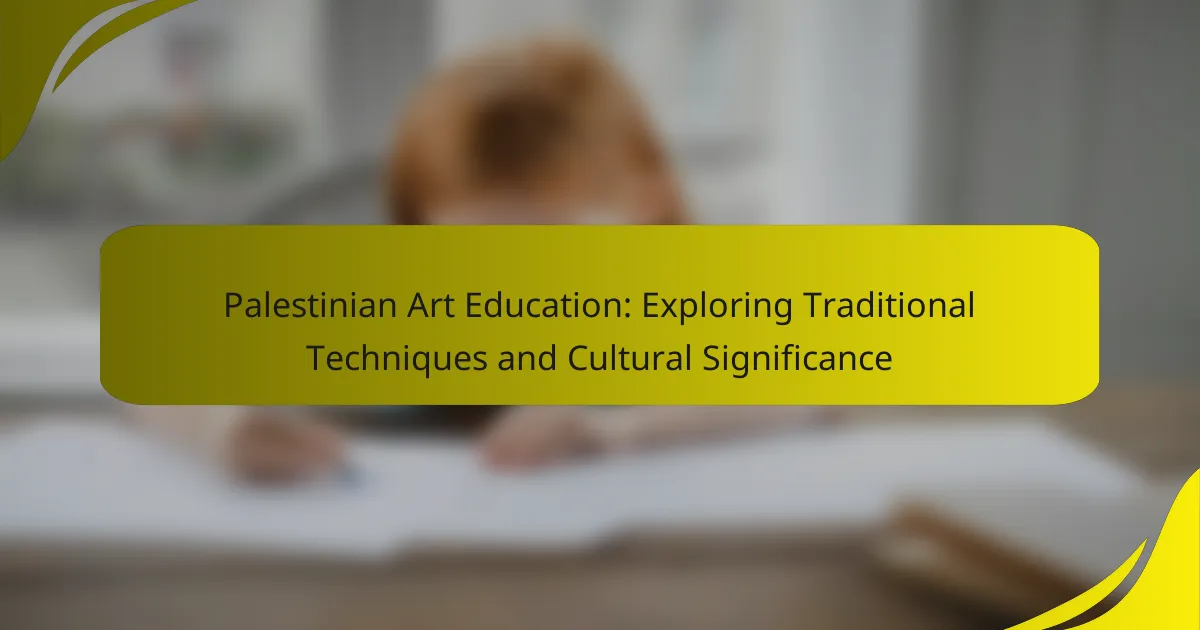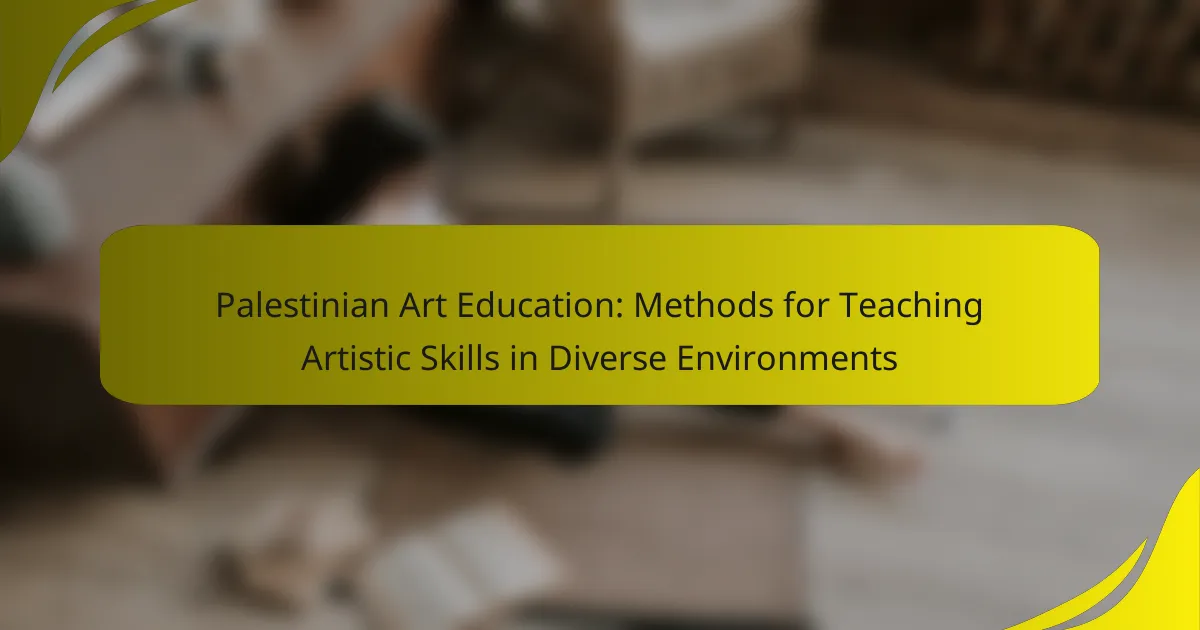Palestinian Art Education emphasizes the teaching and promotion of artistic practices within Palestinian communities, focusing on cultural identity, heritage, and social issues. It aims to empower individuals and foster community engagement through various programs, including workshops and classes, often facilitated by institutions like the International Academy of Art Palestine. The education system faces challenges such as limited resources, political instability, and cultural restrictions, which hinder its effectiveness. Community involvement plays a crucial role in enhancing cultural expression and social cohesion, leading to diverse artistic perspectives and increased community pride. Overall, Palestinian Art Education serves as a vital platform for preserving and promoting Palestinian culture while addressing relevant social issues.
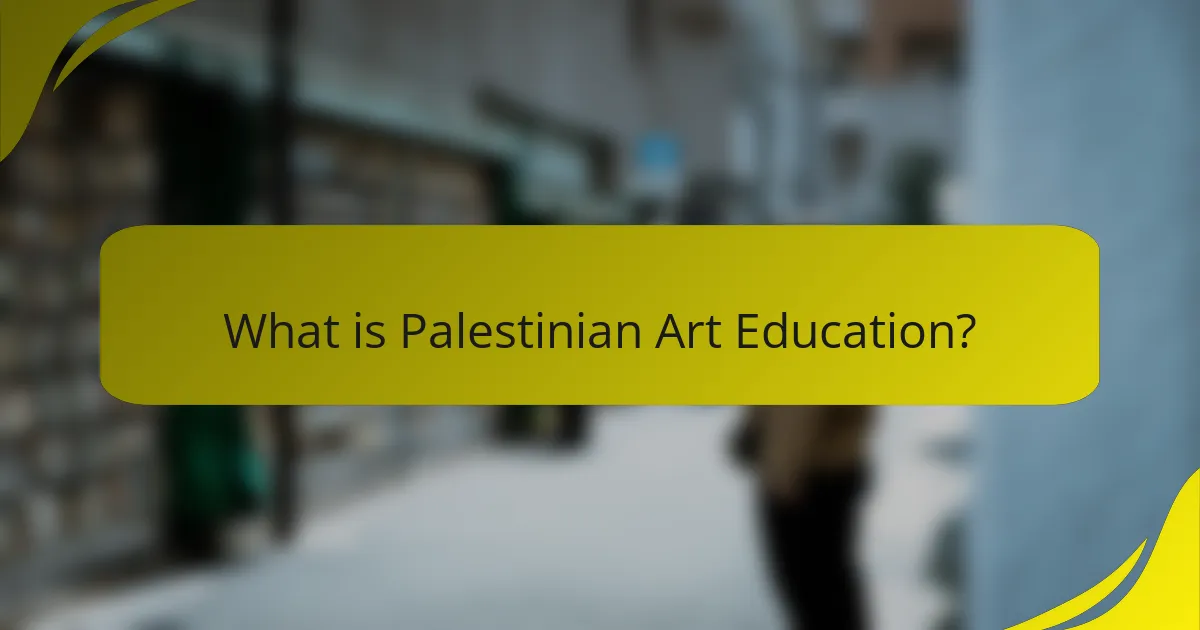
What is Palestinian Art Education?
Palestinian Art Education focuses on teaching and promoting artistic practices within Palestinian communities. It emphasizes cultural identity, heritage, and social issues through various art forms. This education aims to empower individuals and foster community engagement. Programs often include workshops, classes, and collaborative projects. Notable institutions, such as the International Academy of Art Palestine, provide formal education in the arts. These programs encourage critical thinking and creativity among students. Palestinian Art Education also addresses the impact of political and social contexts on artistic expression. This approach helps preserve and promote Palestinian culture globally.
How does Palestinian Art Education differ from other art education systems?
Palestinian Art Education emphasizes community engagement and cultural identity more than many other art education systems. It integrates local history and social issues into the curriculum. This approach fosters a sense of belonging and collective expression among students. Palestinian art education often reflects the political and social context of the region. It encourages artists to address themes of resistance and resilience. Workshops and collaborative projects are common, promoting teamwork and shared experiences. This contrasts with more individualistic approaches seen in Western art education. The focus on community helps to preserve cultural heritage and promote social change.
What historical factors have shaped Palestinian Art Education?
Palestinian Art Education has been shaped by historical factors such as occupation, cultural heritage, and socio-political movements. The Israeli occupation since 1967 has significantly influenced art education by imposing restrictions on resources and freedom of expression. Palestinian cultural heritage, including traditional crafts and folklore, has been integrated into educational curricula to foster identity. The rise of the Palestinian Liberation Organization in the 1960s emphasized the importance of art in national identity. International support and collaboration with global art institutions have also played a role in developing art education. The impact of the First and Second Intifadas highlighted art as a means of resistance and expression. These factors collectively have created a unique landscape for Palestinian art education that reflects resilience and cultural pride.
What are the core principles of Palestinian Art Education?
The core principles of Palestinian Art Education include cultural identity, social justice, and community engagement. Cultural identity emphasizes the expression of Palestinian heritage through art. This principle aims to preserve and promote local traditions and narratives. Social justice focuses on addressing political and social issues through artistic expression. It encourages artists to reflect on their experiences and advocate for change. Community engagement involves collaborative projects that unite artists and local communities. This principle fosters a sense of belonging and collective creativity. Together, these principles aim to empower individuals and strengthen community ties through art.
Why is community important in Palestinian Art Creation?
Community is crucial in Palestinian art creation because it fosters collaboration and cultural expression. Artists often draw inspiration from shared experiences and collective narratives. This connection enhances the emotional depth of their work. Community involvement also provides support and resources for artists. Collaborative projects can amplify voices and address social issues. Historical contexts, such as the impact of conflict, shape the themes in Palestinian art. Art becomes a medium for storytelling and preserving heritage. Ultimately, community strengthens the identity and resilience of Palestinian artists.
How does community engagement influence artistic expression?
Community engagement significantly influences artistic expression by fostering collaboration and shared narratives. Artists often draw inspiration from the experiences and stories of their communities. This connection can lead to a richer, more diverse body of work. For instance, community art projects encourage participation, allowing individuals to express their identities. In Palestinian contexts, collective experiences shape the themes and mediums used in artwork. The collaborative process can also enhance skills and techniques among participants. Research shows that community-based art initiatives can improve social cohesion and cultural identity. Such engagement helps to reflect the community’s values and struggles through art.
What role do local traditions play in community-driven art?
Local traditions are foundational to community-driven art. They provide cultural context and identity. Artists often draw inspiration from historical practices and narratives. This connection fosters a sense of belonging among community members. Local traditions also influence the themes and techniques used in artworks. For example, traditional motifs may be incorporated into contemporary pieces. This blending of old and new creates a dialogue between generations. Ultimately, local traditions enrich the artistic landscape and ensure its relevance to the community.

What are the main challenges facing Palestinian Art Education?
The main challenges facing Palestinian Art Education include limited resources, political instability, and cultural restrictions. Limited resources affect access to materials and facilities necessary for art education. Political instability creates an environment where educational institutions struggle to operate effectively. Cultural restrictions often limit the expression and themes that can be explored in art. Additionally, the lack of trained educators in the field further hampers the development of art programs. These factors collectively inhibit the growth and sustainability of art education in Palestine.
How do political and social factors impact art education in Palestine?
Political and social factors significantly impact art education in Palestine. The ongoing conflict and occupation create an environment of instability. This instability limits access to resources and facilities for art education. Schools often lack proper funding and materials for art programs. Additionally, political restrictions can stifle artistic expression. Many artists face censorship or pressure regarding their work. Social factors, such as community values and traditions, also shape art education. Local culture influences the themes and mediums taught in art classes. Furthermore, community support can enhance or hinder art education initiatives. Overall, the interplay of these factors creates a complex landscape for art education in Palestine.
What are the barriers to access for aspiring artists?
Barriers to access for aspiring artists include limited financial resources, lack of educational opportunities, and restricted access to materials. Many artists face economic challenges that hinder their ability to invest in art supplies and education. In Palestine, art institutions may be underfunded, affecting the quality and availability of art programs. Additionally, cultural and political factors can restrict freedom of expression, limiting artistic exploration. According to a study by the Palestinian Ministry of Culture, over 60% of aspiring artists reported financial constraints as a significant barrier. Furthermore, access to galleries and exhibition spaces is often limited, reducing visibility for emerging artists.
How do economic constraints affect art education programs?
Economic constraints significantly limit art education programs. These limitations often result in reduced funding for materials, facilities, and qualified instructors. Consequently, fewer resources hinder the quality of art education provided to students. In many cases, programs may face cuts or even closures due to budgetary pressures. For instance, schools may eliminate art classes in favor of core subjects deemed more essential. Research indicates that areas with economic challenges experience a decline in cultural resources, which directly impacts students’ exposure to the arts. This situation can lead to a lack of creative opportunities for young artists. Ultimately, economic constraints create barriers that diminish the overall effectiveness of art education programs.
What initiatives support Palestinian Art Education within communities?
Several initiatives support Palestinian Art Education within communities. These initiatives include community art centers, workshops, and cultural festivals. Organizations like the Al-Quds University Arts Department promote artistic expression through formal education. Local NGOs often provide resources and training for aspiring artists. The Art and Culture Association organizes exhibitions to showcase local talent. Additionally, international partnerships facilitate art programs that empower youth. These efforts aim to enhance artistic skills and foster cultural identity.
How do local organizations promote art education?
Local organizations promote art education through workshops, exhibitions, and community events. They provide hands-on experiences for participants of all ages. Workshops often focus on various artistic techniques and mediums. Exhibitions showcase local artists and their work, fostering appreciation for the arts. Community events create a platform for collaboration among artists. These organizations often partner with schools to integrate art into the curriculum. They may also offer scholarships to support aspiring artists. Research indicates that such initiatives enhance cultural awareness and creativity within communities.
What role do workshops and community events play in fostering art education?
Workshops and community events play a crucial role in fostering art education. They provide hands-on learning experiences for participants. These events encourage collaboration among artists and learners. Workshops often feature skilled instructors who share techniques and knowledge. Community events create a supportive environment for creative expression. They help build connections between artists and the local community. Research indicates that community involvement enhances artistic skills and appreciation. Events can also showcase local talent, promoting cultural heritage. Overall, these activities enrich the art education landscape significantly.
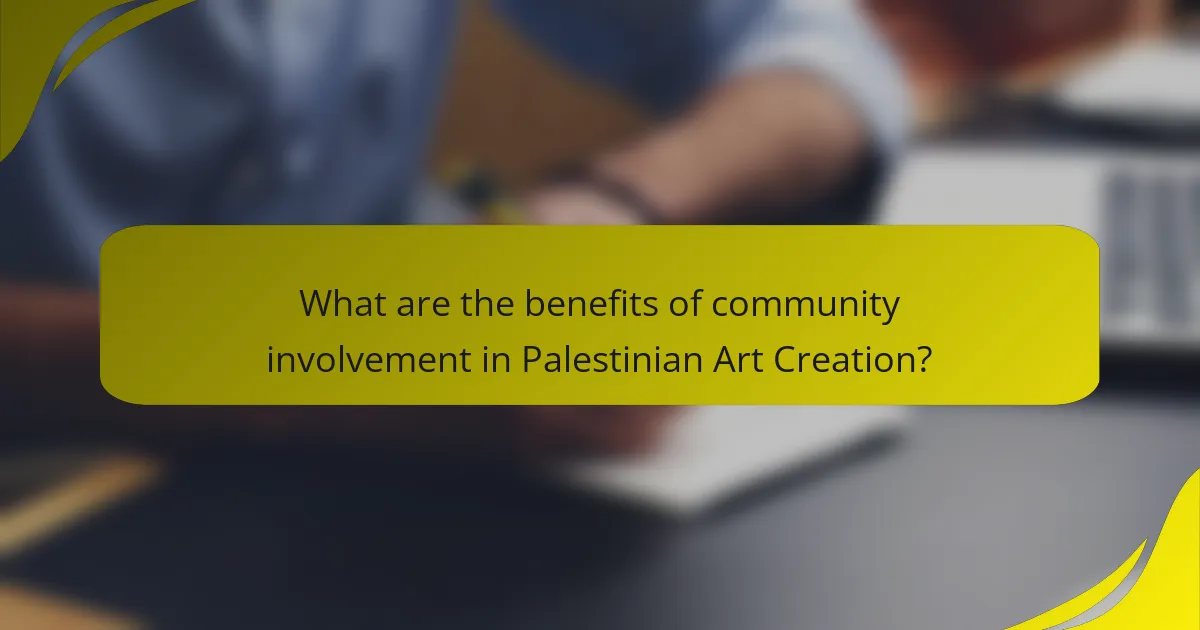
What are the benefits of community involvement in Palestinian Art Creation?
Community involvement in Palestinian art creation enhances cultural expression and social cohesion. It fosters collaboration among artists and community members. This collaboration leads to diverse artistic perspectives. Increased participation strengthens community identity and pride. Engagement in art projects can also provide educational opportunities. Workshops and events promote skills development for participants. Community art initiatives often address social issues relevant to the Palestinian context. They can raise awareness and inspire activism through visual storytelling. These benefits contribute to a vibrant cultural landscape that reflects shared experiences and aspirations.
How does community collaboration enhance artistic outcomes?
Community collaboration enhances artistic outcomes by fostering diverse perspectives and skills. This collaboration allows artists to integrate various cultural influences into their work. It encourages innovation through shared ideas and resources. According to a study by the National Endowment for the Arts, community-based projects often yield more dynamic and relevant art. Collaborating with community members can also strengthen emotional connections to the artwork. This connection often leads to increased audience engagement and support. In Palestinian art education, community involvement can reflect local narratives and experiences. Thus, community collaboration significantly enriches the artistic process and its final products.
What impact does community support have on emerging artists?
Community support significantly enhances the development of emerging artists. It provides essential resources such as funding, mentorship, and networking opportunities. These resources are crucial for artists to gain visibility and credibility in the art world. Community engagement fosters collaboration, leading to innovative projects and shared learning experiences.
Research indicates that artists with strong community ties are more likely to succeed professionally. A study published in “Art Education” found that community involvement increases access to exhibitions and sales opportunities. Furthermore, support networks can boost an artist’s confidence and motivation. Emerging artists often rely on community feedback to refine their work. In summary, community support plays a vital role in the growth and success of emerging artists.
How can community art projects foster cultural identity?
Community art projects can foster cultural identity by providing a platform for shared expression. They engage individuals in creating artworks that reflect their cultural heritage. This process encourages participants to explore and celebrate their unique traditions. Art projects often involve storytelling, which strengthens communal bonds. They create a sense of belonging among participants. For instance, in Palestinian communities, art projects often incorporate traditional motifs and narratives. These elements preserve cultural history and promote awareness. Studies show that such initiatives can enhance community cohesion and pride.
What best practices can enhance community involvement in Palestinian Art Education?
Engaging the community in Palestinian Art Education can be enhanced through several best practices. Establishing partnerships with local artists fosters collaboration and mentorship. Organizing community workshops encourages participation and skill development. Creating inclusive spaces for dialogue allows diverse voices to be heard. Implementing art programs in schools promotes early engagement with art. Utilizing social media platforms raises awareness and connects the community. Encouraging exhibitions of local artists’ work showcases talent and inspires others. Providing resources and funding for community projects supports sustainability. These practices have been shown to strengthen community ties and enhance the overall impact of art education initiatives.
How can art educators effectively engage with local communities?
Art educators can effectively engage with local communities by fostering collaborative projects. These projects can include community art exhibitions, workshops, and public art installations. Collaboration encourages participation and builds trust between educators and community members. Educators should actively involve local artists to enhance cultural relevance. This involvement can create a sense of ownership among participants. Research shows that community-driven art initiatives increase local engagement and cultural pride. For instance, the “Community Arts Program” in Palestine has successfully integrated local traditions into educational practices. Engaging with local schools and organizations can further strengthen these connections. Regular feedback from community members also ensures that programs meet their needs and interests.
What strategies can be used to sustain community art initiatives?
Engaging the community through participatory projects sustains community art initiatives. These projects foster collaboration among local artists and residents. Regular workshops encourage skill-sharing and creativity. Establishing partnerships with local organizations enhances resource availability. Funding through grants and donations provides financial support. Promoting events increases visibility and community involvement. Documenting and showcasing the art process builds a sense of ownership. Feedback loops ensure the initiatives evolve based on community needs.
Palestinian Art Education focuses on teaching and promoting artistic practices within Palestinian communities, emphasizing cultural identity, heritage, and social issues. The article explores how this education differs from other systems, shaped by historical factors such as occupation and socio-political movements. It highlights the core principles of cultural identity, social justice, and community engagement, while addressing the challenges faced, including limited resources and political instability. Additionally, the role of community involvement in enhancing artistic expression and fostering cultural identity is examined, alongside initiatives that support art education and best practices for sustaining community engagement.
